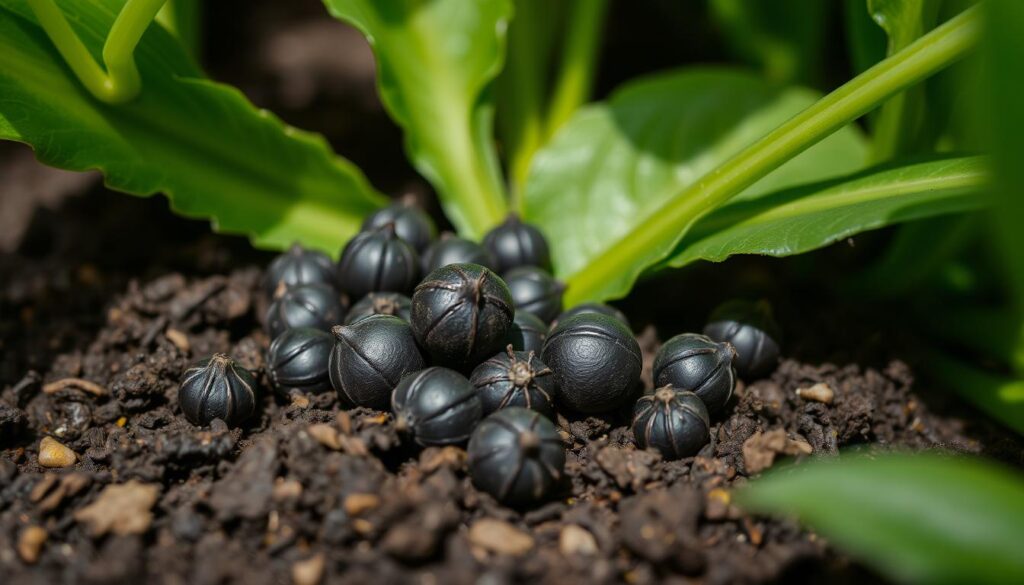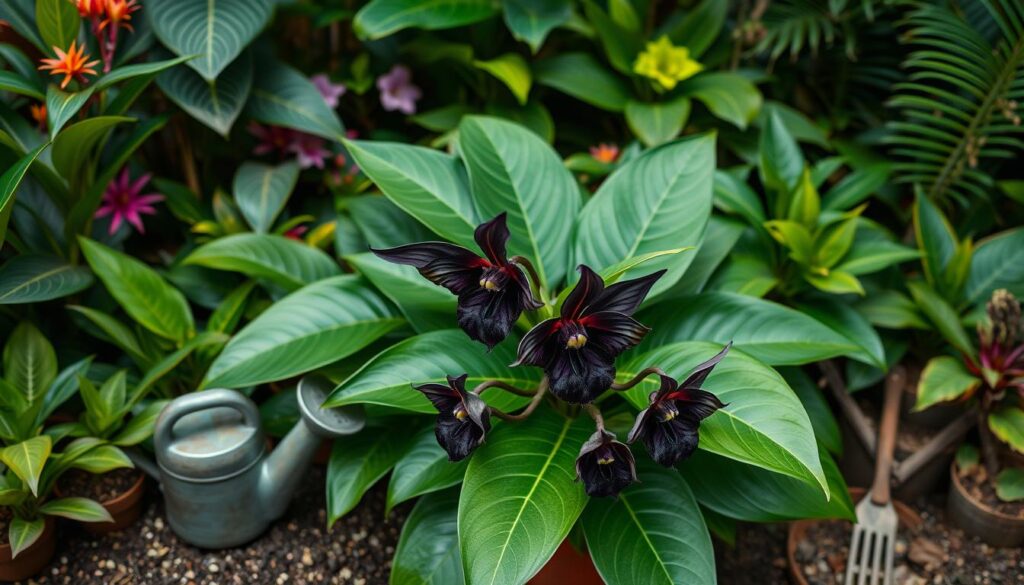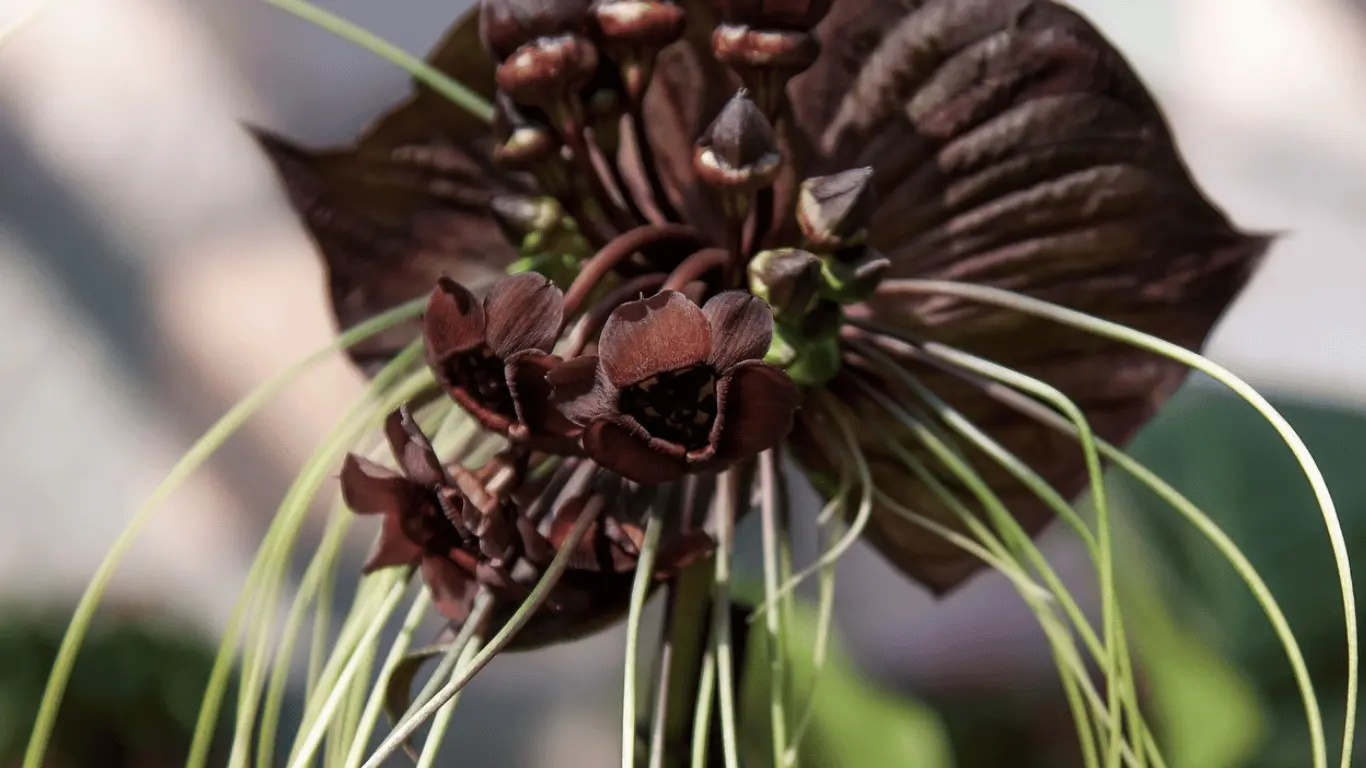I’ve always been fascinated by the black bat flower (Tacca chantrieri). It’s a plant that catches the eye with its unique look. It can turn any garden into a magical place. Imagine the surprise and joy your guests will feel when they see it.
This guide is for anyone who loves plants or is new to exotic gardening. It will teach you how to grow the black bat flower. Get ready to learn about its origins, special features, and how to care for it.
Table of Contents
Introduction to the Mysterious Black Bat Flower
Get ready to explore the world of the black bat flower, Tacca chantrieri. This plant is found in Southeast Asia’s tropical forests. It looks like a bat in flight, fascinating botanists, gardeners, and nature lovers.
Origins and Natural Habitat
The black bat flower comes from the humid areas of Thailand, Malaysia, and Indonesia. It grows well in the shaded parts of rainforests. It feeds on the rich soil and the moist air.
Unique Characteristics of Tacca Chantrieri
The black bat flower stands out with its dark, soft petals and long bracts. These bracts look like a bat’s wings and ears. It attracts moths and bats, showing how it fits into the ecosystem.
Learning about the black bat flower plant is exciting. It lets us see the beauty of nature and the stories of tropical habitats.
“The black bat flower is a stunning example of nature’s ability to create truly unique and mesmerizing forms. Its otherworldly appearance invites us to pause and appreciate the incredible diversity of life that thrives in the world’s tropical forests.”
Understanding Black Bat Flower Varieties and Morphology
The black bat flowers, also known as Tacca chantrieri, are quite fascinating. They have a unique look that draws in gardeners and plant lovers. Their bat-like blooms are especially captivating.
The Tacca chantrieri is a favorite for its large, dark purple or black flowers. These flowers look like a bat’s wings. Long, drooping bracts add to the bat-like appearance.
- The Tacca chantrieri grows 12-18 inches tall. It has broad, green leaves up to 2 feet long.
- The rare Tacca integrifolia has white blooms with a hint of pink. It’s a white version of the classic Tacca chantrieri.
The Tacca plantaginea is another black bat flower variety. It’s smaller and more compact. This makes it great for indoor or container gardens.
“The black bat flower is a true horticultural marvel, captivating all who behold its unique and otherworldly appearance.”
The Tacca chantrieri plant’s shape is amazing. Its flowers grow from a central stalk. They’re surrounded by delicate, lace-like bracts that move in the breeze.
In summary, black bat flowers are a unique and versatile addition. They bring a special charm to any garden or indoor space. They’re sure to impress and inspire everyone who sees them.
Ideal Growing Conditions for Black Bat Flower Success
If you love growing exotic perennials like the black bat flower, knowing the best growing conditions is key. These tropical plants need specific temperatures, humidity, and light.
Temperature Requirements
The black bat flower loves warm, humid places. Keep the temperature between 70°F and 85°F (21°C and 29°C) for the best growth. Don’t let them get below 60°F (15°C), as they can’t handle cold well.
Humidity and Air Circulation Needs
High humidity is crucial for the black bat flower. Try to keep humidity at 60-80% to match their natural home. Make sure there’s good air flow to stop fungal diseases from forming.
Light Requirements
These plants need bright, indirect light. Give them 4-6 hours of filtered or dappled sunlight daily. Direct sunlight can burn their leaves and flowers. If indoors, place them near a south- or east-facing window.
“The Tacca chantrieri is a true showstopper, with its captivating and otherworldly appearance. Providing the right growing conditions is the key to unlocking its full potential.”
Soil Requirements and Potting Guidelines
To grow the black bat flower (Tacca chantrieri) well, you need the right soil. It should be well-draining and rich in nutrients, like its natural home. A mix of peat moss, compost, and coarse sand or perlite works great. It keeps the soil moist but also lets it breathe.
For potting, pick a container that’s a bit wider than the plant’s roots. Make sure it has lots of holes for water to drain. This prevents the plant from getting waterlogged and rotting.
The soil’s pH is key for the black bat flower’s health. It should be slightly acidic, between 5.5 and 6.5. This pH helps the plant absorb nutrients like nitrogen, phosphorus, and potassium.
Repotting the black bat flower regularly is a good idea. Move it to a slightly bigger pot every two to three years. Or when the roots fill the current pot. This supports the plant’s growth and helps it bloom beautifully.
Watering and Fertilization Schedule
Proper watering and fertilization are key for your black bat flowers’ health and growth. These unique perennials need a careful balance to thrive. Let’s explore their watering and nutrient needs.
Water Quality and Frequency
Black bat flowers like moist, but not soggy, soil. Use filtered or distilled water to keep the soil just right. Avoid too much water to prevent root rot.
Water your plants once or twice a week, depending on the weather and soil. In the growing season, you might need to water more often. This helps keep the soil moist.
Fertilizer Types and Application
These exotic perennials do well with a balanced, slow-release fertilizer. Use a water-soluble fertilizer every two to three weeks during the growing season. Or, apply a time-release granular fertilizer once a month.
Choose a fertilizer with a 20-20-20 nutrient ratio. This provides the right mix of nitrogen, phosphorus, and potassium for your black bat flowers.
When fertilizing, follow the manufacturer’s instructions. Avoid over-fertilizing, as it can harm the blooms. Adjust your fertilization based on your black bat flowers’ needs and your growing environment.
“Proper watering and feeding are key to maintaining the health and vibrant appearance of your black bat flowers.”
Propagation Methods and Techniques
If you’re drawn to the black bat flower (Tacca chantrieri), you’ll find propagating it easy. You can grow more black bat flower seeds or divide existing plants. The trick is knowing the right methods and caring for them properly.
One common way to grow Tacca chantrieri is through seed propagation. Collect seeds when the flower pods are mature. Then, sow them in a potting mix that drains well. Germination can take weeks to months. Keep the soil moist and at the right temperature for seed sprouting.
- For division, wait until the plant is well-established, usually in spring or fall. Carefully remove the plant from its pot. Then, separate the rhizomes, making sure each part has a growing point.
- Put the divisions in separate pots with a mix that’s rich in nutrients and drains well. Water them well and keep them in the shade until they grow new leaves.
Both seed propagation and division work well, but Tacca chantrieri can be tricky. Be patient, watch the plants closely, and fix any problems quickly. This will help you succeed.

“Propagating the black bat flower requires a delicate touch, but the effort is well worth it to enjoy the otherworldly beauty of these unique plants.”
Common Pests and Disease Management
Keeping your (Tacca chantrieri) healthy is key to its success. But, like any plant, it can face pests and diseases. Knowing common problems and how to prevent and treat them will help your black bat flower thrive.
Identifying Common Problems
Some common issues for your black bat flower include:
- Spider mites: These tiny arachnids can cause discoloration and wilting of the leaves.
- Aphids: These sap-sucking insects can stunt the plant’s growth and lead to distorted foliage.
- Fungal diseases: Conditions like powdery mildew and root rot can occur due to improper watering or poor air circulation.
- Bacterial infections: Bacterial leaf spot and crown rot can impact the overall health of the plant.
Prevention and Treatment Strategies
To keep your black bat flower healthy, consider these preventive and treatment measures:
- Regular Inspection: Closely monitor your plant for any signs of pests or disease, such as discoloration, wilting, or abnormal growths.
- Organic Solutions: Use natural pest repellents, such as neem oil or insecticidal soap, to manage common pests. For fungal or bacterial issues, employ organic fungicides or antibacterial agents.
- Proper Care: Ensure the Tacca chantrieri is receiving the right amount of water, light, and air circulation, as these factors can make the plant more susceptible to problems.
- Prompt Action: If issues arise, act quickly to address them, as early intervention is key to preventing the spread of pests or diseases.
By staying vigilant and using proactive care, you can keep your black bat flower healthy. This way, you can enjoy its striking and unique appearance for years.
Seasonal Care and Maintenance Tips
Keeping your black bat flower (Tacca chantrieri) healthy needs careful seasonal care. This exotic plant from Southeast Asia needs special care all year. It will thrive and show off its unique blooms if you take good care of it.
Spring Rejuvenation
When spring warms up, your black bat flower will wake up. It’s the best time to repot it in a mix that drains well and has organic matter. Cut off any dead or damaged leaves to help the plant grow new ones.
Summer Splendor
In summer, your black bat flower needs lots of humidity and indirect sunlight. Mist its leaves often and place it in a shaded spot to avoid burning. Use a balanced, slow-release fertilizer to help it grow lush and green.
Autumn Preparation
In autumn, start to water less and lower the temperature to help the plant sleep. Cut back the leaves, leaving a few healthy ones to support the roots during winter.
Winter Hibernation
- In winter, black bat flowers need little to no water and should stay in a cool, dry spot.
- Don’t let the plant get too cold, as it can be damaged.
- Check the soil moisture now and then to prevent root rot.
By following these seasonal care tips, your black bat flower will thrive and show off its beauty every year. Remember, being patient and careful is crucial for growing these perennial plants successfully.

Companion Plants and Garden Design Ideas
Showing off the black bat flower, or devil flower, needs careful planning. Choosing the right plants and garden design can make it stand out. This way, you can create stunning displays that catch everyone’s eye.
Complementary Plant Selection
To make the black bat flower pop, pair it with plants that contrast well. Try using plants like elephant ear, canna lily, or giant rhubarb for a lush look. Also, plants with colors like white or red can add to the beauty.
Design Arrangements for Maximum Impact
- Make the black bat flower the main attraction in your garden. It will grab everyone’s attention.
- Set up a shaded area with tall trees or shrubs. This will mimic its natural home and add to its charm.
- Group several black bat flowers together for a dramatic effect. It will be a showstopper in your garden.
By picking the right plants and designing your garden around the black bat flower, you’ll make it unforgettable. Let this exotic plant be the highlight of your garden.
Conclusion
The black bat flower (Tacca chantrieri) is a true marvel in the world of plants. Its unique look can capture the hearts of many. Whether you’re new to plants or have been growing for years, growing this flower is a rewarding experience.
Learning about its needs and how to grow it can be both challenging and fulfilling. This guide will help you grow a healthy black bat flower. You’ll be able to add something special to your home or garden.
Starting your journey with the black bat flower is exciting. You’ll get to try new things, learn, and share with others. The joy of discovering its quirks makes the hobby so rewarding. So, get started, show off your green thumb, and let the black bat flower amaze you.

